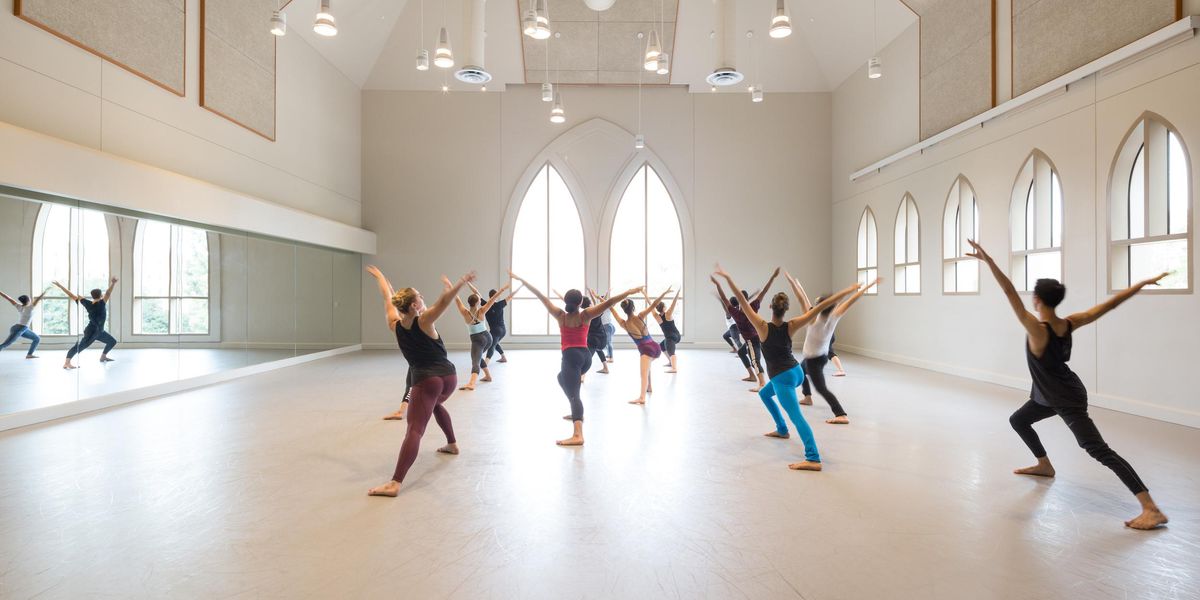The Accidental Choreographer
Pinkleton (in glasses) rehearsing Natasha, Pierre & the Great Comet of 1812 at ART. Photo by Evgenia Eliseeva.
Sam Pinkleton has never danced in a Broadway musical. He’s never assisted a Broadway choreographer or made a piece of concert dance. He’s never even been much of a dancer—“enthusiastic,” he says, but “not terribly skilled.” Nevertheless, with four big-deal credits coming this season, his career as a Broadway choreographer is thriving: He’s doing two musicals, the immersive off-Broadway hit The Great Comet and the more traditional, film-based Amélie; and two straight plays, Heisenberg, the two-character romance by Tony winner Simon Stephens, and Significant Other, Joshua Harmon’s comedy about a gay New Yorker looking for love.
“I sort of very accidentally became a choreographer,” Pinkleton says. He discovered theater early on, growing up just outside of Richmond, Virginia, and always danced. “There was never a moment where I considered myself a serious dancer,” he says. Still, “people let me do things”—things like choreographing his high school show choir. But he saw his path in musical theater rather than dance, and he went to New York University “with big starry-eyed dreams of being a chorus boy.” But he quickly abandoned those dreams, realizing that it felt “like a very strange use of how I think and how I look at the world and how I wanted to be spending my time.” His change of heart was affirmed when his NYU teachers, many of them former Broadway dancers, told him, “Sam, you’re gonna be successful because you have a lot of personality and you work really hard—you’ll be fine, just as long as it doesn’t involve dancing.”
He loved dance, but, he says, “What drew me to it was what happens when your body hears music and nobody’s watching—when you let yourself go.” He switched tracks, leaving “chorus-boy camp” in favor of NYU’s directing program. “I felt an immediate attachment to leading a room and to collaborating,” he recalls. He especially liked that “my voice and ideas are made more interesting when complicated by someone else’s.” And he was lucky, he says, to have flexible collaborators who were open to his movement ideas.
Working on projects downtown and off-Broadway, he amassed both directing and choreography credits. “I started choreographing based on intuition and based on my love for jumping around,” he says, “and really not any technique at all. I don’t know any of those French words.” In 2012, his name first appeared in a Broadway Playbill, as assistant director of The Lyons, Nicky Silver’s dark family comedy. In 2014, still in his 20s, he earned his first choreography credit on Broadway, for the mechanical, expressionistic movement in the Roundabout Theatre Company revival of Sophie Treadwell’s brooding 1928 melodrama, Machinal. But he’s a choreographer without portfolio. “I love the dance world,” he says, “but I can’t claim to be a part of it. When people ask me, ‘What’s your style like?’ I have absolutely no idea. Because I work in theater, and it’s entirely based on the conversation between me and the material, and me and the director.”
He may not have a “style,” but he does have a take. He apologizes for sounding “lofty” as he says, “The joy of dance, my way into dance, is about regular human beings—what they can do, and finding the virtuosity in that.” Whether choreographing a play or a musical, for a proscenium stage or an offbeat space, he wants spectators to feel one thing: “I am a human being in an audience, whether sitting, standing or hanging upside down. And that is another human being, over there, doing something utterly remarkable.” And, he adds, and Broadway will find out, “ ‘remarkable’ could mean any number of things.”
The Great Comet
Dave Malloy’s pop opera The Great Comet, coming to the Imperial Theatre October 18, began life in 2012 as Natasha, Pierre & the Great Comet of 1812. Based on War and Peace, directed at the 99-seat Ars Nova by Rachel Chavkin, the show garnered rave reviews, including one from Sam Pinkleton, who knew Chavkin and Malloy from “the same downtown circles.” The immersive show put the audience in a faux Russian nightclub as Tolstoy’s characters surrounded them singing about their passions. “I loved it so much,” says Pinkleton. “And I enjoyed the free vodka and sent them love letters and went on with my life.” But when he next ran into Chavkin, she told Pinkleton that the nightclub was going to be re-created in a tent in 2013, and that the show was growing to fit the larger space. “She said, ‘I need some help moving bodies around,’ ” Pinkleton recalls. “Neither of us knew exactly what that was going to mean.” There had been only minimal dance at Ars Nova, in the ballroom scenes. With six additional cast members, movement “began to take on its own level of value,” Pinkleton says. With more rave reviews, Natasha, Pierre then moved to American Repertory Theater, in Cambridge, Massachusetts. “We had a cast of 24 and 500 seats and we were doing it in a proscenium,” Pinkleton continues. “With so much ground to cover, and so many people, I realized, Oh my god, this is a dance show now.” Pinkleton says one of his favorite things is that the audience is “surrounded by the action, and they can’t see everything. I had this necessity to make people really dance, and to make sure that, wherever you look, there’s something that maybe you’ve never seen before.”




